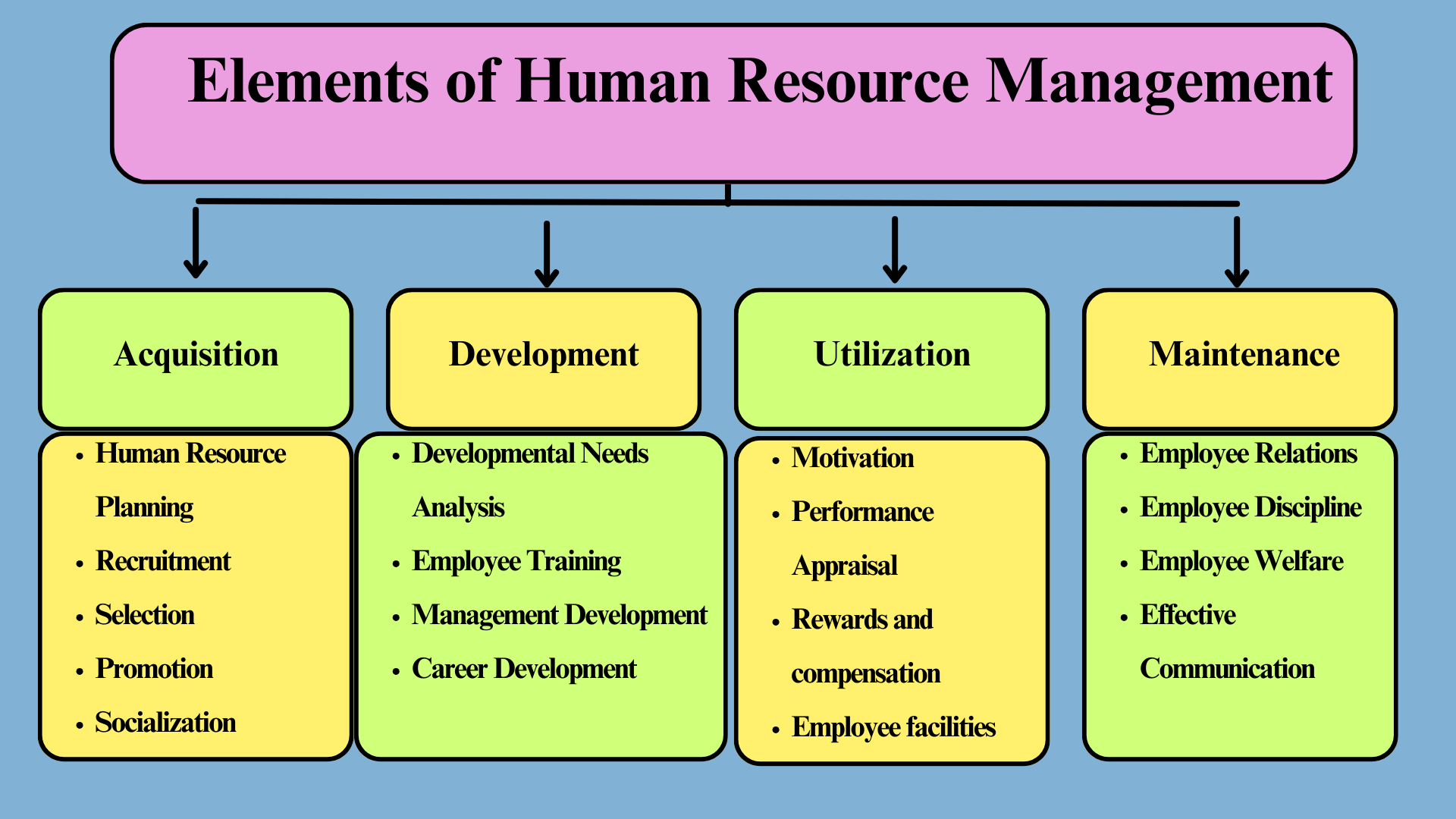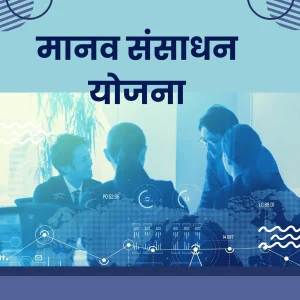Introduction
Human Resource Management (HRM) is the art and science of managing the employees working in an organization. Its main objective is to increase the productivity of employees, keep them satisfied, and help them achieve the goals of the organization. Human resource management encompasses a variety of activities, including the selection, training, evaluation, motivation, and employee relations of employees. In the modern age, human resource management is considered an important part of the organization, which helps the organization achieve long-term success. Human resource management measures the performance and prosperity of the employees available in the organization.
Elements of Human Resource Management
There are various important activities in human resource management, that play an important role in making the organization successful. Those main activities can be divided into four main parts: acquisition, development, utilization, and maintenance.

1. Acquisition
In the acquisition stage, the organization conducts various activities to attract and select the right people. This phase includes human resource planning, recruitment, selection, placement, and socialization.
1.1 Human Resource Planning
Human resource planning is the process of identifying the number and type of employees an organization will need in the future. It involves analyzing the organization’s goals and strategies and determining the needs of employees. It helps the organization get the right people at the right time.
1.2 Recruitment
Recruitment is the process of attracting qualified candidates who are willing to work in an organization. Various sources are used for this, such as advertisements, job fairs, online portals, and references. The recruitment process matches the needs of the organization and the qualifications of the candidates.
1.3 Selection
Selection is the process of selecting the most suitable person from among the admitted candidates. Various methods are used for this, such as written tests, interviews, psychological tests, and reference checks. The selection process helps to choose the person who is qualified, competent, and fits with the organization.
1.4 Promotion
Promotion is the process of assigning responsibilities to a new employee in an organization. It involves familiarizing the new employee with the organization’s work, policies, and culture. It helps employees to be organized and productive quickly.
1.5 Socialization
Socialization is the process of inculcating new employees into the organization’s culture, values, and behaviors. It helps in the assimilation of new employees into the organization and increases their productivity
2. Development
In the development phase, various training and development programs are conducted to increase the skills, knowledge, and abilities of employees. This phase includes development needs analysis, staff training, management development, and career development.
2.1 Developmental Needs Analysis
Developmental needs analysis is the process of identifying the current and future needs of employees. It determines training and development needs by analyzing employee performance, organizational goals, and future challenges.
2.2 Employee Training
Employee training is a program organized to enhance the skills and knowledge of employees. It includes various types of training, such as technical training, management training, and leadership development training. Training increases the productivity and efficiency of employees.
2.3 Management Development
Management development is the process of preparing future leaders. It develops leadership development, decision-making skills, and strategic thinking. Management development provides competent leadership to the organization in the long term.
2.4 Career Development
Career development is the process of providing employees with opportunities for career advancement. These include career planning, promotion, and capacity development. Career development increases employee satisfaction and commitment.
3. Utilization
In the utilization stage, the organization adopts various strategies to increase the productivity and satisfaction of the employees. This phase includes motivation, performance evaluation, rewards and compensation, and employee benefits.
3.1 Motivation
Motivation is the process of motivating employees to perform well. Various methods are used for this, such as praise, rewards, incentives, and opportunities. Motivation increases the productivity and satisfaction of employees.
3.2 Performance Appraisal
Performance appraisal is the process of evaluating the performance of employees. It identifies the weaknesses and strengths of employees by measuring their performance. Performance appraisal helps in the improvement and development of employees.
3.3 Rewards and compensation
Rewards and compensation are the process of recognizing the hard work and contributions of employees. These include bonuses, salary increases, promotions, and other benefits. Rewards and compensation increase employee satisfaction and motivation.
3.4 Employee facilities
Employee facilities are the process of providing various facilities that take care of the welfare of the employees. This includes health care, insurance, housing, transportation, and other benefits. Employee benefits increase employee satisfaction and commitment.
4. Maintenance
In the maintenance phase, the organization adopts various strategies to keep the employees organized and satisfied for a long time. This phase includes employee relations, employee discipline, employee welfare, and effective communication.
4.1 Employee Relations
Employee relations is the process of maintaining good relations in the workplace. It involves open and honest communication, conflict resolution, and building mutual trust between management and employees. Employee relations provide stability and success to an organization.
4.2 Employee Discipline
Employee discipline is the process of keeping employees disciplined. It includes compliance with rules and laws, disciplinary proceedings, and a code of conduct. Employee discipline ensures discipline and adherence to rules in the organization.
4.3 Employee Welfare
Employee welfare is the process of taking care of the well-being of employees. This includes health care, counseling, wellness programs, and other benefits. Employee well-being increases employee satisfaction and commitment.
4.4 Effective Communication
Effective communication is the process of ensuring good communication between management and employees. These include open, clear, and honest communication, feedback exchange, and accurate flow of information. Effective communication builds an environment of trust and cooperation in the organization.
Objectives and Importance of Human Resource Management
The objective of human resource management is to provide efficient, competent, and satisfied employees to the organization. Its importance can be understood from the following points:
1. Effective Personnel Management
Human resource management helps in achieving organizational goals by managing employees effectively. It provides the organization with the right people at the right time.
2. Optimum utilization of resources
Human resource management increases the productivity and efficiency of an organization through the efficient utilization of human and physical resources. It helps the organization achieve more results with fewer resources.
3. Increase in Productivity
Human resource management increases the overall productivity of the organization by enhancing the skills, knowledge, and motivation of employees. It makes the organization competitive and ensures long-term success.
4. Goal-achieving
Human resource management focuses the efforts of employees on achieving the organization’s objectives. It helps the organization to achieve the targeted results.
5. Solving Problems
Human resource management helps to solve various problems and challenges that arise in the organization. It provides stability and progress to the organization.
6. Job Satisfaction
Human resource management increases employee job satisfaction, which increases employee morale and commitment. This ensures a high retention rate for the organization.
7. Self-Development
Human resource management supports the personal and professional development of employees. It increases the capacity and efficiency of employees.
8. Goal Alignment
Human resource management tries to align the objectives of employees with the goals of the organization. It helps the organization achieve the targeted results.
9. Maintaining work quality
Human resource management ensures a high quality of work life. It increases employee satisfaction and productivity.
10. Adaptation of changes
Human resource management helps organizations and employees accept and adapt to changes. It makes the organization competitive and adaptable.
Human Resource Management in Public Enterprises
Human Resource management is the process of recruitment, selection, placement, training, evaluation, and development of employees. This management is extremely important in a public institution, as it has a direct impact on the efficiency, productivity, and dedication of the organization and its employees. Human resource management (HRM) in public enterprises is the process of managing employees’ performance, satisfaction, and various activities to achieve organizational goals. It is very important for the successful operation of the institute, which helps in maximizing the potential, efficiency, and dedication of the employees. Public sector corporations are various departments, bodies, and agencies of the government, that work for the service of the people and the welfare of society.
Major functions of Human Resource Management
1. Recruitment and selection of employees
Selection and recruitment of qualified and competent employees in a public institution is an important task. A transparent and fair selection process attracts qualified people and increases the efficiency of the institute. Recruitment of employees should also be done based on diversity, keeping in mind the needs of the organization. It encourages diversity and inclusion in the institute.
2. Training and Development
It is necessary to organize regular training programs to increase the efficiency and skills of the employees. Training is provided on new technologies, regulations, and procedures. Training enhances the skills and competencies of employees, which helps in improving the performance of the organization. Training programs increase employee confidence and morale.
3. Performance Appraisal
Human resource management evaluates the performance appraisals of employees and takes corrective action accordingly. An effective appraisal system helps identify employees’ strengths and weaknesses. Rewards and incentives are given to top-performing employees based on evaluation, which motivates other employees to do better.
4. Employee Relations
Building healthy and positive employee relations in a public institution is extremely important. Human resource management can organize various programs to maintain mutual cooperation, trust, and harmony among employees. It boosts the morale of the employees and encourages their dedication to work.
5. Welfare Programs
Human resource management organizes various welfare programs to take care of the well-being of employees. These include health care, counseling, and recreational activities. Employee welfare programs increase their satisfaction and morale, which has a positive impact on the performance of the institute.
Problems and challenges of Human Resource management in public enterprises
Various problems and challenges may arise while managing human resources in public enterprises. Solutions to these problems and challenges are equally important. Here are the major problems and challenges and their solutions:
1. Lack of Qualified and Competent Staff
Problem: Public enterprises often lack qualified and competent staff. This has a direct impact on the organization’s performance and service delivery.
Reasons:
- Attractive private-sector competition.
- Low pay and benefits.
- Traditional and slow recruitment process.
Solution:
- Transparent and fair recruitment process: The recruitment process should be conducted with fairness and transparency.
- Attractive Salary and Benefits: The government should offer attractive salaries and benefits that can compete with the private sector.
- Quick and efficient recruitment process: A quick and efficient recruitment process should be adopted to select qualified Human resources on time.
2. Low Enthusiasm of Employees:
Problem: In many public enterprises, there is low enthusiasm and dedication of employees. This has a negative impact on their performance.
Reasons:
- Lack of incentives and rewards.
- Heterogeneous work environment.
- Lack of opportunities for personal and professional development.
Solutions:
- Incentives and reward programs: Rewards and incentives should be given to the best-performing employees.
- Performance Appraisal System: A regular and structured appraisal system should be implemented.
- Professional Development Opportunities: Training and development programs should be conducted for the personal and professional development of employees.
3. Lack of technical skills
Problem: Lack of modern technical skills is also a major challenge in public enterprises. Employees without technical skills find it difficult to adopt and use new technologies.
Reasons:
- Lack of adequate investment in training and development.
- Lack of training in the latest technologies.
- Lack of institutional support.
Solution:
- Training in the latest technologies: Regular programs should be conducted to train in new technologies.
- Technical Skill Development Programs: Special programs should be conducted to develop technical skills.
- Adequate investment in training and development: An adequate budget for training and development should be ensured.
4. Political interference
Problem: Political interference is a major problem in many public enterprises. This hampers fairness and transparency.
Reasons:
- Political pressure in appointments and promotions.
- Interference in employee discipline.
- Political influence in policy making.
Solution:
- Policy to maintain autonomy and fairness: A policy should be made to make the organization autonomous and maintain fairness.
- Enforce strict rules: Strict rules should be enforced to prevent political interference.
- Fairness in appointment and promotion: Fairness should be followed in the selection of qualified and competent employees.
5. Lack of resources
Problem: Lack of resources is also a challenge in public enterprises. This hinders the training, development, and well-being of employees.
Reasons:
- Lack of budget.
- Uneven distribution of resources.
- Lack of effective resource management.
Solution:
- Effective budget management: Effective budget management should be done.
- Equitable distribution of resources: Equitable distribution of resources should be ensured.
- Investment in training and development: A sufficient budget should be managed for training and development.
6. Lack of Performance Appraisal System
Problem: Many public enterprises lack an effective performance appraisal system. This makes it difficult to objectively evaluate the performance of employees.
Reasons:
- Lack of clear criteria.
- Personal bias in appraisal.
- Lack of regular appraisal.
Solution:
- Establishment of clear and measurable standards: Clear and measurable standards should be established for the evaluation of job performance.
- Training for Fair Appraisal: Appraisers should be trained for fair appraisal.
- Regular and structured evaluation system: A regular and structured evaluation system should be implemented.
7. Organizational Culture and Environment
Problem: Organizational culture and environment in public enterprises can also be challenging. This can have a negative impact on employee morale and performance.
Reasons:
- Resistance to change.
- Unhealthy work environment.
- Politics and factionalism within the organization.
Solution:
- Positive attitude towards change: A positive attitude towards change should be adopted.
- Healthy and supportive work environment: A healthy and supportive work environment should be created.
- Resolution of politics and factionalism within the institute: Politics and factionalism within the institute should be resolved.
Therefore,
It is necessary to adopt various measures to solve the problems and challenges of Human Resource management in public enterprises. Hiring, training, and development of qualified and competent employees, incentives and rewards, minimization of political interference, proper management of resources, an effective performance appraisal system, and a positive organizational culture and environment bring positive changes in organizational performance and productivity. It helps make the organization more efficient, transparent, and accountable, which ultimately helps achieve the target objectives of the institute.
Major challenges of human resource management
Major challenges in human resource management arise due to various reasons. These challenges are detailed below:
1. Globalization:
Globalization has created a situation where organizations have to compete at the international level. This brings with it the challenge of having to take into account the diversity of employees, cultural differences, and legal and regulatory norms.
2. Change Management:
Rapid economic, technological, and social changes force organizations to continuously improve. Failure to manage change effectively can reduce employee morale and reduce organizational productivity.
3. Large Organizations:
Communication and coordination among employees is difficult in large organizations. Also, large organizations take longer to make decisions and implement policies.
4. Technological Changes:
Technological changes force organizations to continuously innovate in their operational processes. This requires a huge investment in the training and development of employees.
5. Legal Environment:
Different countries have different legal and regulatory norms. Adhering to these rules can be challenging and can impact an organization’s strategy and policies.
6. Employee Empowerment:
Empowering employees increases their productivity and satisfaction. However, for this, the organization should provide proper training, development opportunities, and autonomy.
7. Knowledge Management:
Effectively managing knowledge and skills within an organization is a challenge. It helps in increasing the competitive advantage of the organization.
8. Size and Complexity:
Management is difficult in large and complex organizations. Coordination and communication between different departments and branches should be strengthened.
9. External Resources:
Contracting, outsourcing, and getting services from consultants can be challenging. This can affect the core objectives and performance of the organization.
10. Work-Life Balance:
Maintaining a work-life balance for employees can be challenging. An imbalance can negatively impact employee satisfaction and productivity.
Conclusion
Human resource management is the cornerstone of the stability and success of an organization. It helps in attracting qualified and competent employees, which gives the organization a long-term competitive advantage. Effective human resource management helps increase employee satisfaction, productivity, and engagement. It helps in achieving the goals of the organization along with the personal development of the employees. Through HRM, an organization can manage the skills and knowledge of workers, which are essential for innovation and improvement. It helps the organization to remain stable in the changing market conditions. Ultimately, HRM plays an important role in making the organization sustainable and successful.





